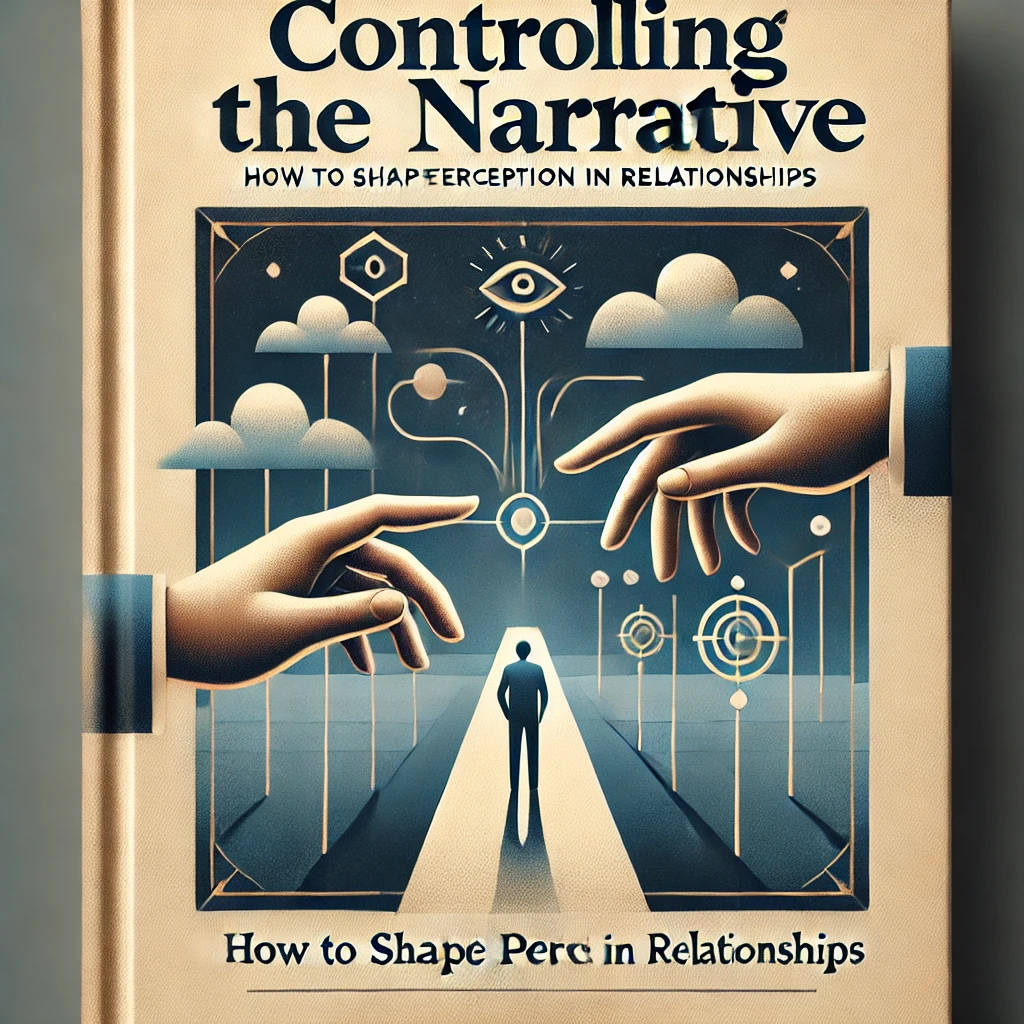In every relationship, the way we communicate, frame situations, and present information plays a huge role in shaping how our partners perceive us and the relationship itself. What if you had the power to guide these perceptions—to subtly influence how your partner sees situations, feels about them, and ultimately reacts? Welcome to the world of controlling the narrative, one of the most subtle yet effective forms of influence in any relationship.
Controlling the narrative doesn’t mean twisting the truth or manipulating facts; it’s about presenting events, discussions, and even conflicts in a way that benefits both you and your partner. It’s about framing situations in a way that leads your partner toward the conclusion you want, without forcing them into it. Done skillfully, this technique allows you to influence decisions, ease tensions, and avoid conflict, all while maintaining open communication.
In “Mastering Him: The Secret Art of Gentle Control in Relationships”, Chapter 8 dives deep into controlling the narrative, revealing how this powerful tool can be used to steer conversations and guide your partner’s emotions and decisions—often without them even realizing it. Let’s take a closer look at how controlling the narrative works, why it’s so effective, and how you can use it in everyday life to build stronger, more harmonious relationships.
What Does It Mean to Control the Narrative?
Controlling the narrative means managing how events, situations, or conversations are framed and interpreted. It’s the art of storytelling in relationships—taking charge of how things are presented, so that the outcome aligns with your goals. Rather than letting circumstances dictate how your partner perceives a situation, you proactively guide that perception through careful word choice, emphasis, and timing.
In practical terms, it’s about shaping the emotional and intellectual context around any event or interaction. For example, if a disagreement arises, instead of focusing on the conflict, you might emphasize the opportunity for growth or the importance of your shared goals. By doing so, you’re controlling how the situation is remembered and how future decisions are made.
Why Controlling the Narrative Works in Relationships
The reason this technique is so effective is because perception is reality. How someone interprets a situation often dictates how they react to it. If you can control the narrative, you can subtly guide your partner’s emotional response and thought process, making it more likely that they’ll reach a conclusion that benefits both of you.
People naturally respond to how information is presented. When you frame things positively or focus on shared benefits, your partner is more likely to feel good about the situation. Conversely, when you allow negative framing or let emotions escalate, your partner may become defensive or resistant. Controlling the narrative helps you avoid unnecessary tension and steer the relationship in a more positive, constructive direction.
Real-Life Examples of Controlling the Narrative
Let’s explore some real-life examples of how controlling the narrative can play out in everyday relationship situations. These examples will show how subtle shifts in framing can make a big difference in how conversations unfold and decisions are made.
Example 1: Framing Conflicts as Opportunities for Growth
Disagreements are inevitable in relationships, but how you frame those disagreements can change everything. When conflict arises, controlling the narrative means shifting the focus from the disagreement itself to the potential growth that can come from resolving it together.
Controlling the Narrative in Action:
Let’s say you and your partner are arguing about how to spend money. Instead of focusing on the argument or assigning blame, you might say, “I think this is a great opportunity for us to work together and figure out a financial plan that makes both of us feel secure and happy.” You’ve reframed the argument as a collaborative challenge, rather than a fight.
Why It Works:
By shifting the narrative away from conflict and toward a shared goal, you’re less likely to make your partner feel defensive. They’ll be more open to working with you to solve the issue, because the focus is on the positive outcome, not the disagreement.
Example 2: Reframing Disappointments
Sometimes plans don’t go as expected, but how you present the situation can influence how your partner feels about it. Controlling the narrative means focusing on the silver lining, rather than dwelling on what went wrong.
Controlling the Narrative in Action:
Imagine you and your partner planned a weekend getaway, but bad weather ruins the trip. Instead of letting the disappointment take over, you could say, “It’s a bummer the weather didn’t cooperate, but now we have the chance to have a cozy weekend at home together, which we rarely get to do.” You’ve reframed the situation in a way that turns a negative into a positive.
Why It Works:
By controlling the narrative and focusing on the new opportunity, you prevent negative emotions from taking root. Your partner is more likely to accept the situation and feel good about the unexpected change of plans.
Example 3: Guiding Decisions with Positive Framing
When it comes to making decisions—big or small—how you present the options can make a huge difference in which path your partner chooses. Controlling the narrative in these situations means emphasizing the benefits of the option you prefer, while still making your partner feel like the decision is theirs.
Controlling the Narrative in Action:
Let’s say you’re trying to decide where to go on vacation. You prefer a beach destination, while your partner is considering a mountain retreat. Instead of saying, “I don’t want to go to the mountains,” you could say, “I’ve been thinking about how relaxing it would be to spend a week by the ocean—imagine the sunsets, the warm sand, and the fresh seafood. I think we’d both feel so refreshed afterward.” You’ve highlighted the benefits of your choice in a way that makes it sound appealing, without directly dismissing your partner’s idea.
Why It Works:
By focusing on the positive aspects of your preferred option, you’re guiding your partner toward seeing it as the best choice, all while keeping the conversation collaborative. This subtle influence makes it more likely that your partner will lean toward your suggestion.
Example 4: Turning Criticism into Constructive Feedback
In every relationship, there are moments when you need to address something your partner did that upset or frustrated you. Controlling the narrative in these situations means framing the conversation in a way that emphasizes growth and understanding, rather than blame.
Controlling the Narrative in Action:
Instead of saying, “You never listen to me,” you might say, “I’ve noticed that sometimes we misunderstand each other during conversations, and I think it’s something we could work on together. I really want us to be able to hear each other better.” By focusing on improving communication, rather than accusing your partner of a fault, you’re steering the conversation toward a constructive resolution.
Why It Works:
This approach reduces defensiveness and encourages your partner to see the issue as something to work on as a team. By controlling the narrative, you make it easier for your partner to hear your concerns without feeling attacked.
The Ethics of Controlling the Narrative
Here’s where things get a little controversial: Is controlling the narrative always ethical?
The answer lies in intent. If you’re controlling the narrative to manipulate or deceive your partner, then it crosses the line into toxic behavior. But if you’re using this technique to foster understanding, reduce conflict, or create positive outcomes, it can actually strengthen the relationship.
Controlling the narrative doesn’t mean lying or omitting important details. It means framing situations in a way that benefits both of you, ensuring that conversations lead to constructive outcomes rather than unnecessary conflict. When used ethically, controlling the narrative can create an atmosphere of collaboration, where both partners feel heard and respected.
How to Recognize When You’re Controlling the Narrative
If you’re wondering whether you’re controlling the narrative in your relationship, here are a few questions to ask yourself:
- Am I framing the situation positively or negatively?
- Am I guiding the conversation toward a shared goal?
- Is my partner’s perspective being acknowledged, or am I only focusing on my own needs?
- Am I being honest, or am I omitting information to get the outcome I want?
The goal of controlling the narrative should always be to create a positive, constructive conversation where both partners feel empowered.
Q&A:
- What does “controlling the narrative” mean in relationships?
Controlling the narrative means guiding how events, conversations, or conflicts are framed to shape your partner’s perception in a way that fosters positivity and understanding. It’s about steering the interpretation of situations through careful wording, timing, and emphasis, rather than leaving perception to chance. - How can I subtly influence my partner’s perception in a positive way?
You can subtly influence your partner’s perception by emphasizing shared goals, focusing on positive outcomes, and framing conflicts as opportunities for growth. For instance, instead of fixating on problems, you could discuss the benefits of resolving them, making it easier for your partner to view situations constructively. - What are examples of controlling the narrative in a relationship?
Examples include framing disagreements as chances to strengthen communication, highlighting the benefits of decisions you support, and focusing on silver linings during disappointments. For example, if bad weather ruins plans, framing it as an opportunity to enjoy a cozy day together can ease disappointment and shift focus to a positive aspect. - Is controlling the narrative considered manipulation in relationships?
Controlling the narrative is only manipulative if it’s used to deceive or force outcomes solely for personal gain. When used ethically, it’s about fostering understanding and positive outcomes, making it a constructive tool for guiding conversations and strengthening the relationship. - How can framing situations help reduce conflict with my partner?
Framing situations positively shifts focus away from blame or negative emotions, reducing defensiveness and tension. For example, if you say, “Let’s find a solution together that works for both of us,” rather than pointing out flaws, it fosters collaboration and helps prevent arguments from escalating. - What are ethical ways to control the narrative with a partner?
Ethical ways to control the narrative include open communication, honesty, and an emphasis on shared goals. Frame conversations in ways that prioritize both partners’ needs and present options or solutions that lead to mutual benefit, avoiding any deceitful tactics or omissions of key information. - How does controlling the narrative impact relationship harmony?
Controlling the narrative, when done with respect and positivity, reduces misunderstandings and creates a more harmonious relationship. By shaping how situations are perceived, you foster empathy, minimize unnecessary conflicts, and help both partners feel more aligned in their outlook and goals. - What is the difference between influence and manipulation in relationships?
Influence encourages positive outcomes and respects both partners’ needs, while manipulation often involves deceit, force, or pressure to meet one-sided goals. Influence is constructive, aiming for mutual benefit, whereas manipulation crosses ethical boundaries by disregarding a partner’s autonomy or well-being. - Can controlling the narrative help build trust in relationships?
Yes, if used to frame situations constructively and foster open dialogue, it can build trust. When your partner feels they’re being guided toward positive outcomes rather than forced or misled, it strengthens their faith in your intentions and builds a foundation of respect and understanding. - What are the signs that someone is controlling the narrative in a relationship?
Signs include consistently framing conversations in ways that reduce conflict, emphasizing shared goals, and encouraging collaboration rather than confrontation. If done ethically, it feels positive and constructive; if it feels one-sided or manipulative, it might indicate an unhealthy approach to controlling the narrative.
Ready to Master the Art of Subtle Influence in Your Relationship?
If you’re ready to dive deeper into the world of influence and learn how to control the narrative in your relationship, “Mastering Him: The Secret Art of Gentle Control in Relationships” is your ultimate guide. In Chapter 8, you’ll discover powerful techniques for framing conversations, guiding decisions, and shaping outcomes—all while maintaining respect and trust in your relationship.
This book isn’t just about manipulation—it’s about understanding the psychology of influence and using it to build stronger, more harmonious relationships. Get your copy today and start mastering the art of subtle control in your relationship, because understanding how to influence the narrative is the key to lasting harmony and connection.
Read more about the book: https://developmentpill.com/mastering-him-the-secret-art-of-gentle-control-in-relationships-a-guide-to-influence-hell-never-see-coming/
Book Link: https://www.amazon.com/dp/B0DKKGLZQ9
Book Link UK: https://www.amazon.co.uk/dp/B0DKKGLZQ9
You can find book Links for other regions in this post page: https://developmentpill.com/mastering-him-the-secret-art-of-gentle-control-in-relationships-a-guide-to-influence-hell-never-see-coming/



